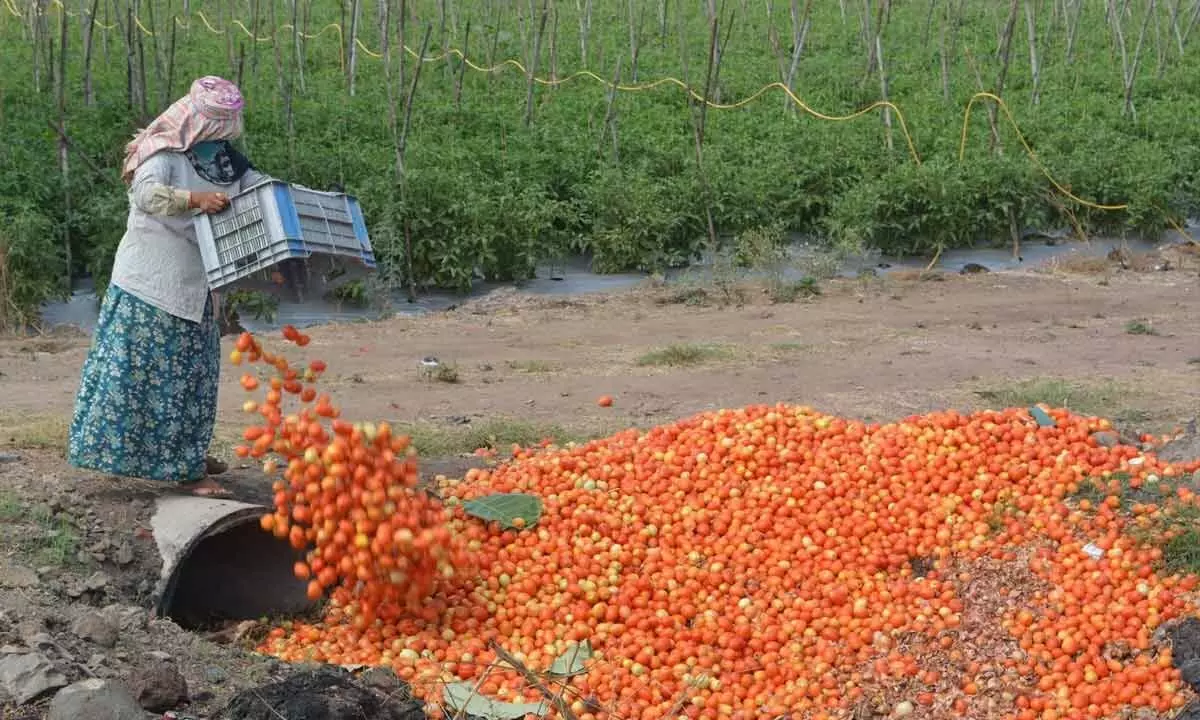If small farms gone, distress sets in

If small farms gone, distress sets in
Those espousing market reforms need only to look at small agri farms crisis in US
It is quite disheartening. Every time you speak of falling farm prices, the troll takes it on. “This is what farm laws were supposed to address. But the opposition from farmers, led by middlemen and anti-national elements, thwarted it. Now bear the consequences,” goes the refrain.
While talking about falling capsicum prices, which forced Punjab farmers to throw the vegetable on the streets, what comes as a shock is that most city-bred, who have no inkling of the worsening agrarian crisis that prevails, takes to twitter to espouse, instead, the corporate interest. Mention about the soaked wheat bags lying in the mandis after an intermittent spell of unusual rains, brings up similar arguments. Without even understanding that the lack of mandi infrastructure is a reflection of the failure of successive governments to provide adequate public sector investment in agriculture, the twitterati used the social media to vent their frustration at the withdrawal of three contentious farm laws after a year-long protest by farmers.
But talk of the recent New York Times report (April 19, 2023) that quotes the National Rural Health Association’s policy brief pointing to the US farm suicide rate to be 3.5 times higher than the general population, all is quiet. After all, if the private sector has been doing so well, then how come such a large number of American farmers are forced to take the fatal route? Shouldn’t farmers be well off in an agricultural environment where private sector dominates, especially in a country where there are no APMC regulated mandis nor is there any Minimum Support Price (MSP).
Take a look at another news report in USA Today that says farmers in Iowa province are a worried lot. The cost of production has gone up significantly whereas they, too, are anticipating low-farm gate prices. It is as if the ‘farm to flop’ phenomenon – that I had related the collapse of prices of onion, tomato, potato, brinjal, capsicum and other vegetables in India during the past two months with – had hit the American shores.
Just to give you an idea of how farmers are being fleeced, the US Department of Agriculture’s cost of milk production estimates for 2021 show that on an average, farmers lose $ 6.72 per hundred weight of milk produced every day. For small dairy farmers, with less than 50 cattle, the loss is much bigger, at $21.58 per hundred weight.
I thought the educated people, and some of them with a sizeable following on the social media, should be asking these pertinent questions. In fact, the troll merrily says the day Indian agriculture comes under the corporate yoke, it will turn profitable. If that be so, I fail to understand why in the US, with its corporate farming and where hardly 1.5 per cent family farms are left to survive, farmers are at the receiving end? Why are farm incomes so low; why and how do farmers continue to survive with median farm incomes being in the negative unless of course the federal support drums up the farm economics?
These are questions that have been very conveniently pushed under the carpet. Since economists remain struck in the inexorable growth narrative, they do not even want to raise these questions, lest it points to the flawed and outdated economic thinking. Even in America, despite corporate agriculture, much of the farm income per household is coming from non-farm activities. With 48.6 per cent of the US farm households living with negative income, to believe that big farm is the solution is to hammer a death-knell in small-scale agriculture.
I don’t expect the right wing troll to answer these difficult questions but perhaps the spin doctors should reframe the template for the troll army.
It is not as if Indian policy makers had not earlier tried pushing in market reforms in agriculture. I remember the excitement in policy circles after Bihar had thrown away the APMC Act and had withdrawn from the mandis, saying that Bihar would be the harbinger of a new market-oriented agriculture. This was in 2006, and for several years in the beginning the market-oriented farm revolution refrain was pitched on a high scale. But when the illusionary turnaround in agriculture did not take place, the exuberance paled out. The tall claims made by the dominant class of market economists were simply forgotten.
Bihar has paid a heavy price for its failed experiment with market reforms in agriculture. For over 15 years after they were unleashed, the state’s small-scale agriculture has decayed further. With agriculture turning out to be grossly unviable, Bihar has now turned into a national hub for providing labour work force for the country. This is what happens when policy makers get tuned to an ideological thinking, without realising the high social and developmental costs involved.
Even today, a large proportion of the farm workforce in Punjab comes from Bihar. It’s not the other way around. This is primarily because Punjab has a well-laid out market infrastructure and where Minimum Support Price (MSP) for wheat and paddy is the norm.
Bihar farmers also produce wheat and paddy. They too work heard, but in the absence of regulated markets and an assured price by way of MSP, they get a price which is far less than what Punjab farmers receive. That is why we see a stream of farm workers migrating to Punjab every year. These workers could have been easily absorbed in the farm sector in Bihar provided it had strengthened the APMC Act (instead of throwing it out) and spread the wide network of procurement mandis and purchase centres.
Bihar countryside wouldn’t have been as despicable as it is today. In the same way, it’s all quiet in the American countryside. With farmers increasingly pushed out of agriculture, the US countryside is also a picture of deafening silence and disquiet.
In the November 27, 2019 issue of the Time magazine, the headline said it all. “They’re trying to wipe us off the map. Small American farmers are nearing extinction.”
The scale may be different, but what we see in the Bihar countryside as far as economic deprivation is concerned is not much different from the severity of the farm crisis that has gobbled up small farms and is sinking rural America.
The loss of a decade and a half that Bihar has undergone is a heavy price for pushing in a flawed economic design as far as agriculture is concerned. Unfortunately, there are hardly any lessons learnt. Not even after the protesting farmers forced the withdrawal of three contentious farm laws.














